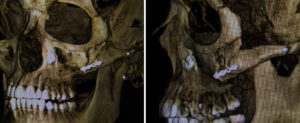
What then is the potential cause of facial sagging after cheekbone reduction? As can be seen by the anatomic attachments, this is not primarily due to loss of muscular insertions. Rather it is due to a combination of subperiosteal stripping of the soft tissue from the face of the zygoma and loss of skeletal support due to a cheek deprojection effect. When the front and back end of the zygomatic arch is cut and pushed inward, this bone movement can also inadvertently move the bone and its attached soft tissues downward. This can be other source of facial sagging…deep internal collapse. But any one of these adverse tissue effects alone may not cause facial sagging. It usually every involved factor to create this adverse tissue effect.
Thus any cheekbone reduction surgery carries the risk of facial sagging but most techniques of zygoma and zygomatic arch reduction surgery will not cause this aesthetic problem. However some reduction methods are more prone to it if the bone is not stabilized by osteotomy design or plate and screw fixation. Downward displacement of the zygoma and the zygomatic arch bone causes tissue prolapse into the submalar and masseteric spaces. This kind of facial sagging is very difficult to correct.
Facial sagging after cheekbone reduction is very different from that of the typical effects of facial aging. Facial skin and the underlying SMAS layer sag due to weakening and stretching of the osteocutaneous ligaments which run between the underside of the skin down to the bone.. This is why jowls and deepening of the nasolabial folds occur. The deep tissues remain intact but the more superficial tissues essentially slide off the face. In facial sagging after skeletal reduction, it is the osteocutaneous ligaments that have lost their attachments. This type of tissue sag is much deeper, down at the bone level, and is not so easily remedied by merely sliding the skin ‘back up into place’.
Restoration of soft tissue sagging after cheekbone reduction is challenging but not impossible. There are two main types of secondary corrective approaches. (tissue repositioning and volume restoration) In some cases, a facelift type approach may be used but this is rarely successful. The direction of skin pull is away from where the tissue is sagging and in the wrong vector. If a skin pull approach is used, it needs to be done more vertically and directed towards the temporal region. This often requires a combined temporal and intraoral (sublabial) approach for tissue resuspension and fixation.
But volume restoration also can have an important role to play in restoring midface tissue sagging. Reprojecting the anterior cheek (not the width) by the intraoral placement of an implant is the simplest and most effective soft tissue lifting method. But understandingly most patients are reticent to consider the placement of a synthetic material. Fat injections can also be used and, while natural, does not offer much of a push to lift tissues. In very rare cases, the cheek bones themselves can be repositioned but this is very difficult and no guarantee of lifting prolapsed soft tissues. An implant should trump an attempt at osteotomy reversal.
In summary facial sagging after cheekbone reduction is a problem best avoided. Choosing a favorable osteotomy pattern and proper and careful execution will avoid it most of the time. If it occurs early intervention is advised, ideally no earlier than three months before but no later than six months after the surgery.
Dr. Barry Eppley
Indianapolis, Indiana


